Fall’s Functional Disorientation
September 29th, 2025
I’ve been noticing a connection between the mess and confusion of an impending fall garden — as I sift through the wonderfully unkept one I’ve just inherited with my move to a little farm in Healdsburg, CA — and my own interior world, which feels much the same. What seems to show up as disorientation, chaos, confusion, and a general sense of difficulty — the kind that feels hard to overcome — may just simply be part of the cycles of life, or the process’ of the seasons, circular and repeating. And in my case, part of what I call a major growth spurt.
I tend to make sense of things more easily when I’m in the garden, connected to the herbs I adore and the cycles I get to witness so viscerally. Witnessing the garden — physically touching the herbs — has always helped me make better sense of what’s inside me, reminding me that I, too, am like nature — shifting, growing, letting go — and that truth is both comforting and a quiet kind of wisdom I can’t seem to ignore.
As I pick and pluck and pull the seemingly dead plants and insert new seeds and seedlings for the futue, I see the black magic of fall revealing itself as something more potent and moving than it seems. What can look like dying, feels more like growth if you examine it close enough and kind of get in there deep—it’s beautiful and fully alive from that perspective.

Once again, the garden mirrors me — or likely I’m mirroring it. This seasonal process is always a transformation. I have deep gratitude for making my way back to the garden, to the herbs, the plants, and my own resilience which I tend to notice more in this grounded space.
I’ve had a hell of a year so far, which is why you haven’t heard much from me. The past few months have felt like they’ve broken me. Losing my longtime sidekick, Inca, left a deep hole, and the world — caught in a strange transition between AI and technology trying to think for humans — collided with a slew of personal and professional obstacles, pushing my body and mind to implode in anger, resentment, and just about every other negative emotion you can imagine.
I’m sure everyone I crossed paths with could feel it — my behavior, my negativity. I don’t regret it; it was simply the product of deep disorientation, the kind that comes with major transition and a fork in the road where you decide which emotions to feed for the future.
It’s not the first time I’ve felt this way, and it won’t be the last. But this one was severe, and I don’t think it’s a coincidence that my own inner chaos exploded just as the world itself seems tangled in massive confusion.
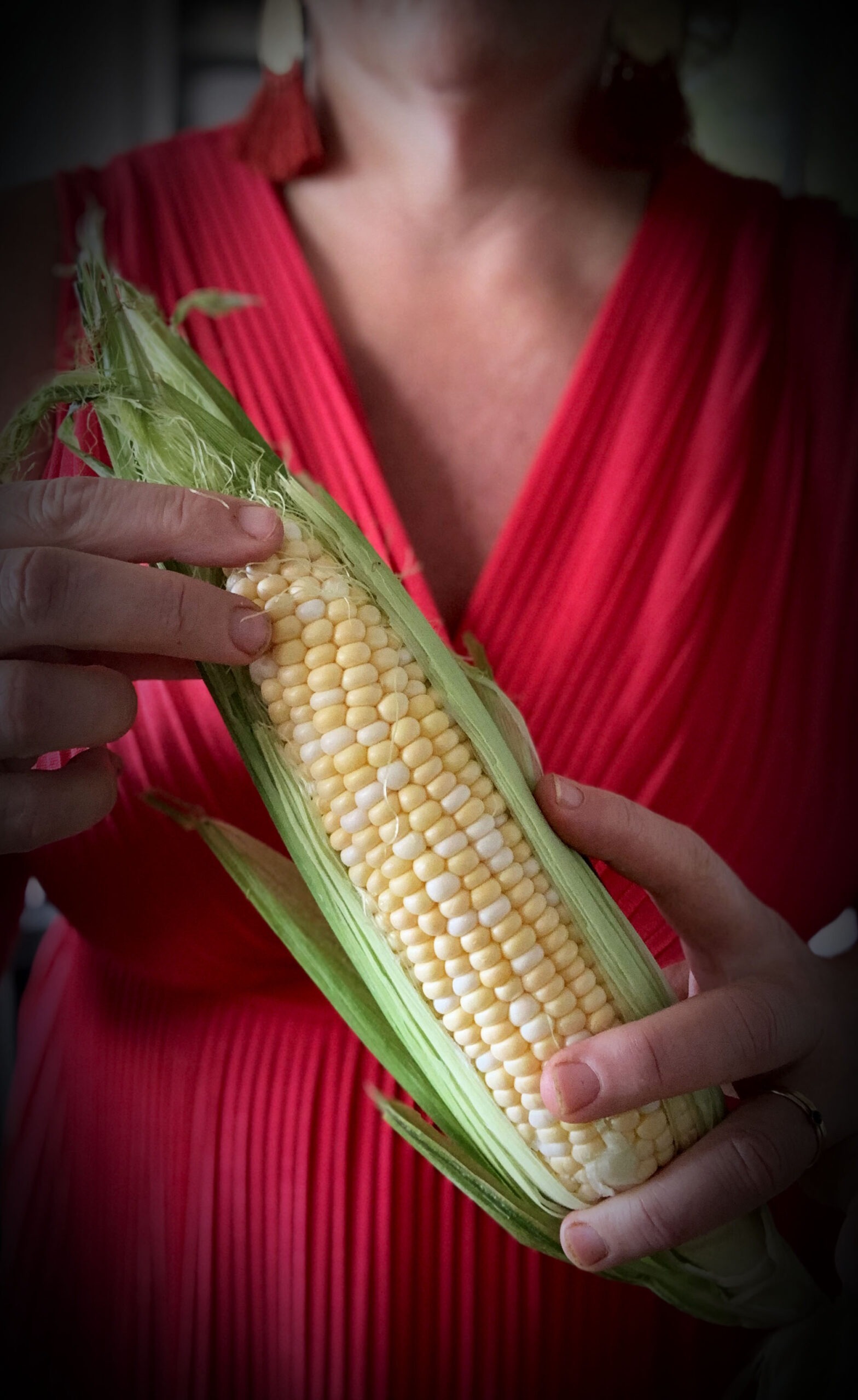
The only way I’ve learned to move through disorientation is to be intentional about the energy you let surround you and to give yourself the time it takes to climb out. It’s a quiet process, a humble one. It can’t happen without a significant amount of self-compassion and the help of others — and, as I’ve said before, it’s often the most unlikely people who show up. The path forward starts in that first, fragile decision to choose it. You realize you can’t move until you feel compassion for others too. It’s a paradox: selfishness is needed to heal, but in caring for yourself, you also care for the whole.
Climbing out this time took deliberate, difficult personal work, step by step. Eventually, those steps, still in progress, led me back to the garden. And there, I could finally feel my healing — real growth — it did indeed begin. From that journey and the place of noticing or maybe witnessing, these recipes emerged.
I adore the spring, and I love summer, but I’ve begun to notice that my best, most creative work often arrives with fall. It’s a season of disorientation and clarity all at once — like late-summer fruit and vegetables, ripened to their fullest just as they teeter on the edge of sweetness and decay. Harvest brings the satisfaction of labor realized, yet also the quiet truth that what is lush and alive today will soon soften, split, and return to the soil to become something new.

Fall becomes a living metaphor for transition: ripe tomatoes collapsing under their own weight, spent blooms turning to seed, fruit shriveling on the branch. The season insists we release what cannot be held — sometimes nudging us gently, sometimes hurling us headlong into change until we surrender and become something else.
Each year, as I meet fall again, I feel its yin and yang more clearly: abundance and ending, beauty and loss, reflection and release. Within that confusion lives a deeper rhythm — an acceptance that to prepare for renewal, we must move through the messy middle ground where things no longer fit but have not yet transformed. Fall’s black magic lives in that slower in-between.
Where summer dazzles with instant gratification — peaches dripping down your chin, cherries popped straight from the bowl, plums still warm from the sun — fall asks something different of us. Its late fruits and vegetables require patience and coaxing: tomatoes simmered into Bolognese, eggplants softened into caponata, sweet corn ripe with deep vegetal notes, figs sweetness turned nutty and buttery in a crisp cookie. Fall flavors are deep flavors that linger, teaching us that not everything nourishing arrives in a rush. Summer blazes hot and fast; you blink and it’s gone, its fire igniting you without promise of what will come next. Fall reminds you to slow down, to gather what’s ripened, to let go of what can’t last, and to trust the quiet work of transformation.
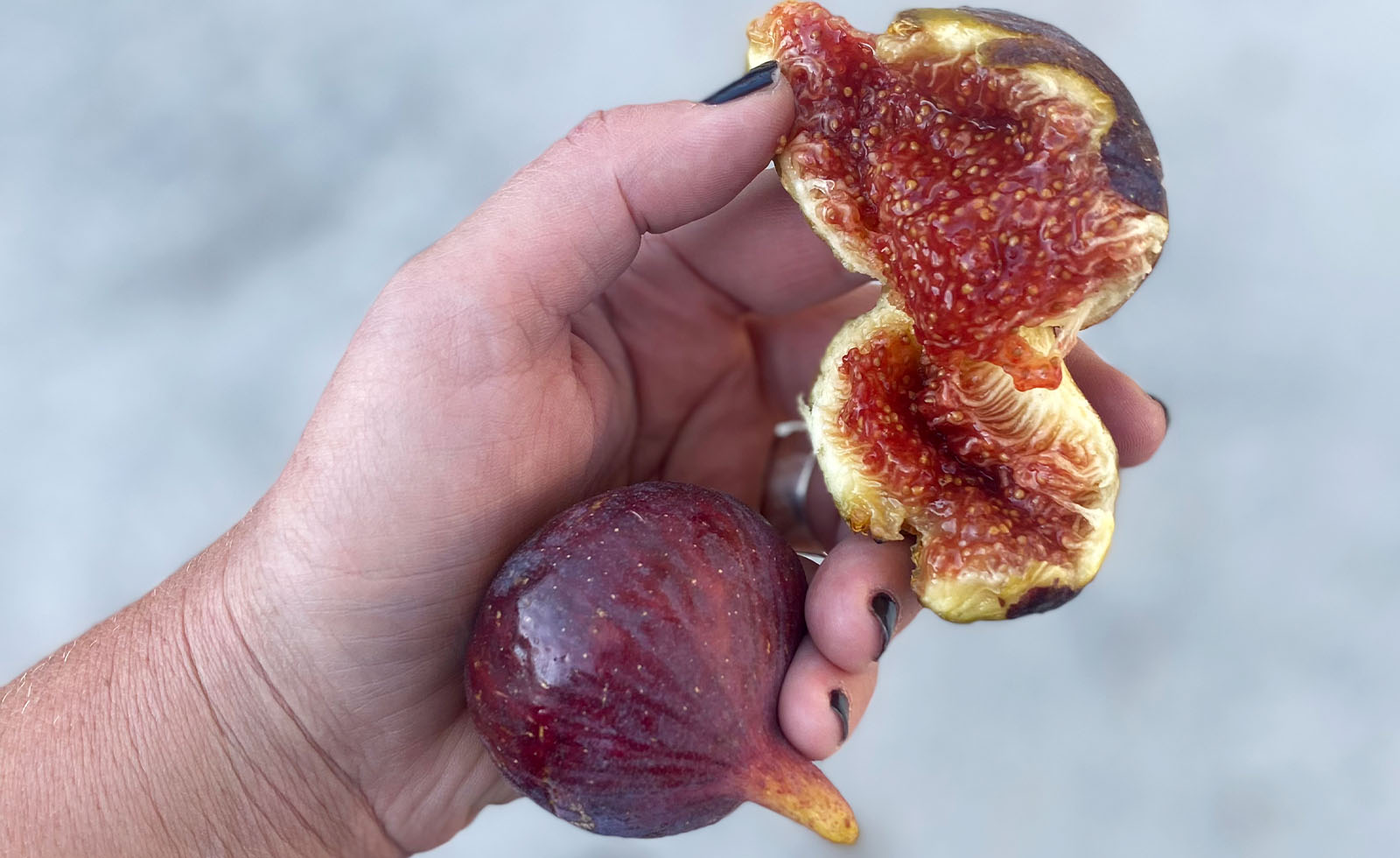
Fall — especially the beginning, its edge, that in-between — is where my life always seems to be shifting in a big way. (Hence the hidden selah tattoo.) The pause. The blank space. The threshold. There’s beauty there, but only if you can live with change — willing to step into the empty, to let go so you can move forward. Inside that pause is where the knowing lives. Sometimes you push, sometimes you rage, sometimes you simply rest and witness. As summer’s craving and striving fade, fall pulls us back to the ground — toward seeing what actually is, right here, right now. Toward slower breaths, slower growth, slower everything, like tomatoes and eggplants stubbornly clinging to the vine while they sweeten into something transformed.
As I get older, I feel an urgent, almost cellular pull to root more deeply — into place, into work that matters, into quiet connection. I crave fewer fireworks and more slow, sustaining fire. The garden gives me that: its mess, its patience, its unhurried wisdom. It asks me to listen, to stay, to tend. As I grow and I see more clearly that wisdom doesn’t arrive polished, I see my recipes reflecting that same brilliance.
These four recipes, Fire Roasted Caponata, Millet, Corn & Basil Salad, Zucchini & Eggplant Bolognese and Fresh Fig, Rosemary Butter Cookies have grown out of my current cycles of growth and creativity, they are as the Buddhists would say in the moment.
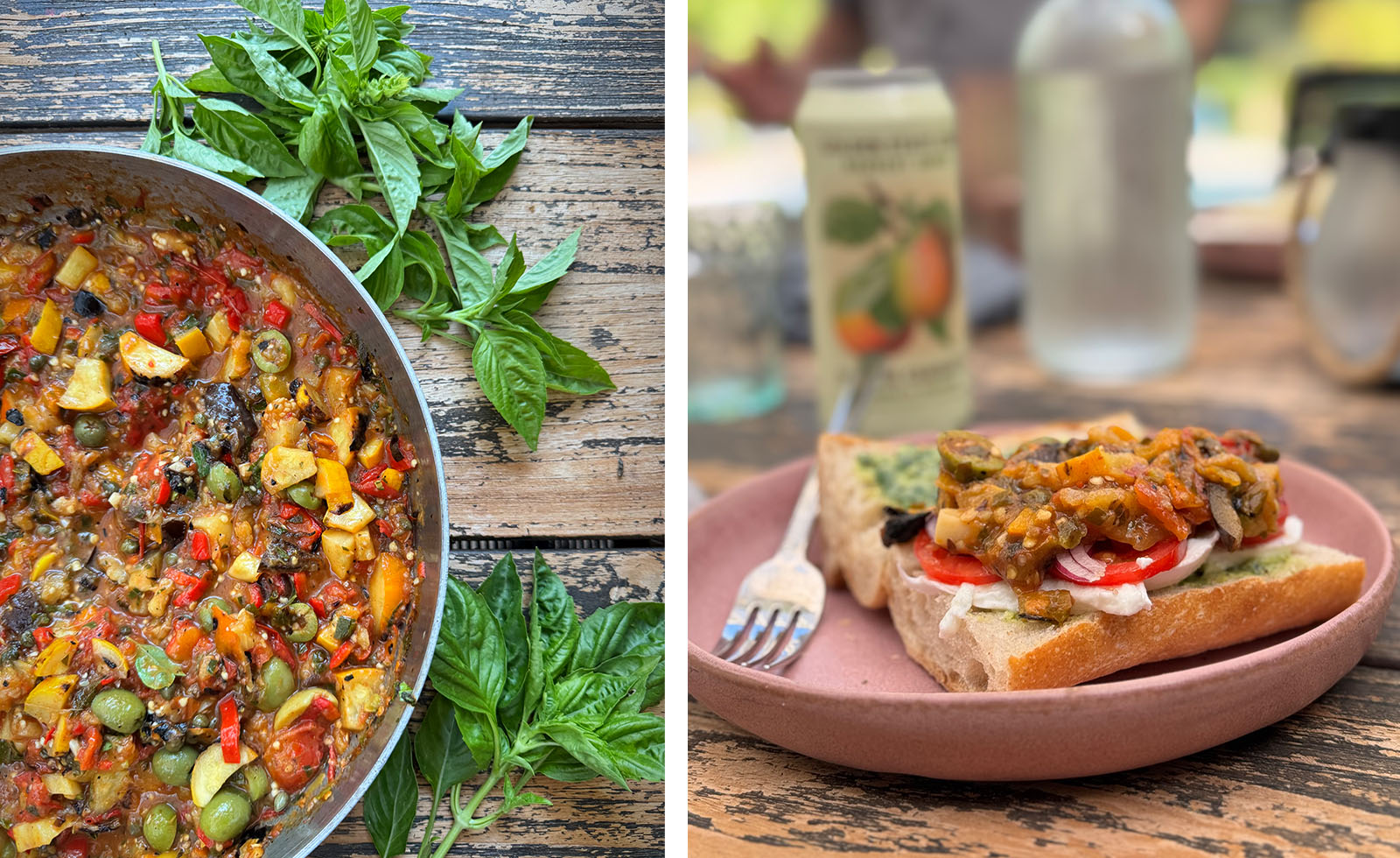
Nissa’s Fire Roasted Caponata
Caponata is a classic Sicilian sauce or relish — a bright, sweet-savory tangle of late-summer vegetables, herbs, olives, and capers, cooked down until everything is soft and deeply flavored. Traditionally, it leans on sugar and vinegar for its sweet-and-sour edge; I use lemon instead and let ultra-sweet tomatoes and fire-roasted eggplant bring the sweetness naturally. As is my way, I make it a little differently — overloading it with herbs, not just the soft green ones of summer but also the woody-stemmed kinds Sicilians love. That mix gives the dish a deeper, earthier character and, to me, a distinctly fall essence. It’s grounded yet vibrant, fresh but with lingering, smoky depth. This isn’t a recipe that demands measuring; it’s meant to be made with whatever the garden gives, so long as you keep the basics. Perfect for the in-between season, when eggplants, peppers, tomatoes, and zucchini tumble into our hands at summer’s end.
Makes about 6-8 cups
Ingredients
5–6 small to medium Japanese eggplant
6–8 small ripe tomatoes, Roma or sauce variety ideal
4–5 small to medium sweet peppers
1–2 small hot peppers
2 medium yellow zucchini
3 tablespoons olive oil
1 teaspoon salt, plus 1–2 teaspoons more
½ red onion, chopped fine
3 cloves garlic
1 teaspoon finely chopped rosemary leaves
1 teaspoon finely chopped sage leaves
1 teaspoon finely chopped marjoram leaves
2 fresh bay leaves
zest and juice of 1 lemon
3 tablespoons capers
½ cup coarsely chopped pitted green olives
1 teaspoon cracked black pepper
2 tablespoons finely chopped parsley
2 tablespoons roughly chopped basil leaves
Directions
Toss the eggplants, tomatoes, sweet peppers, hot peppers, and zucchini with olive oil and a good pinch of salt. Grill everything over an open flame until the skins are blistered and charred, turning as needed for even cooking. For the tomatoes, use a cast-iron pan or comal directly on the grill so they can char while their juices stay contained. Let everything cool just enough to handle, then chop it all finely, making sure to keep every bit of the juices.
In a large pan, warm a splash of olive oil with the lemon zest. Add the garlic and all the chopped woody herbs — rosemary, sage, marjoram, and the bay leaves — and cook, stirring gently until fragrant. Stir in the chopped roasted vegetables (including the juices) with another pinch (teaspoon) of salt and bring the mixture to a simmer. Cook uncovered until everything softens and the juices reduce and thicken. Add the capers, olives, parsley, and basil; cook for another minute or two to meld the flavors.
Remove from heat and let the caponata cool. Refrigerate overnight to let the flavors deepen before serving. Serve with good bread, or pile onto a sandwich with fresh mozzarella, ripe tomatoes, and basil.
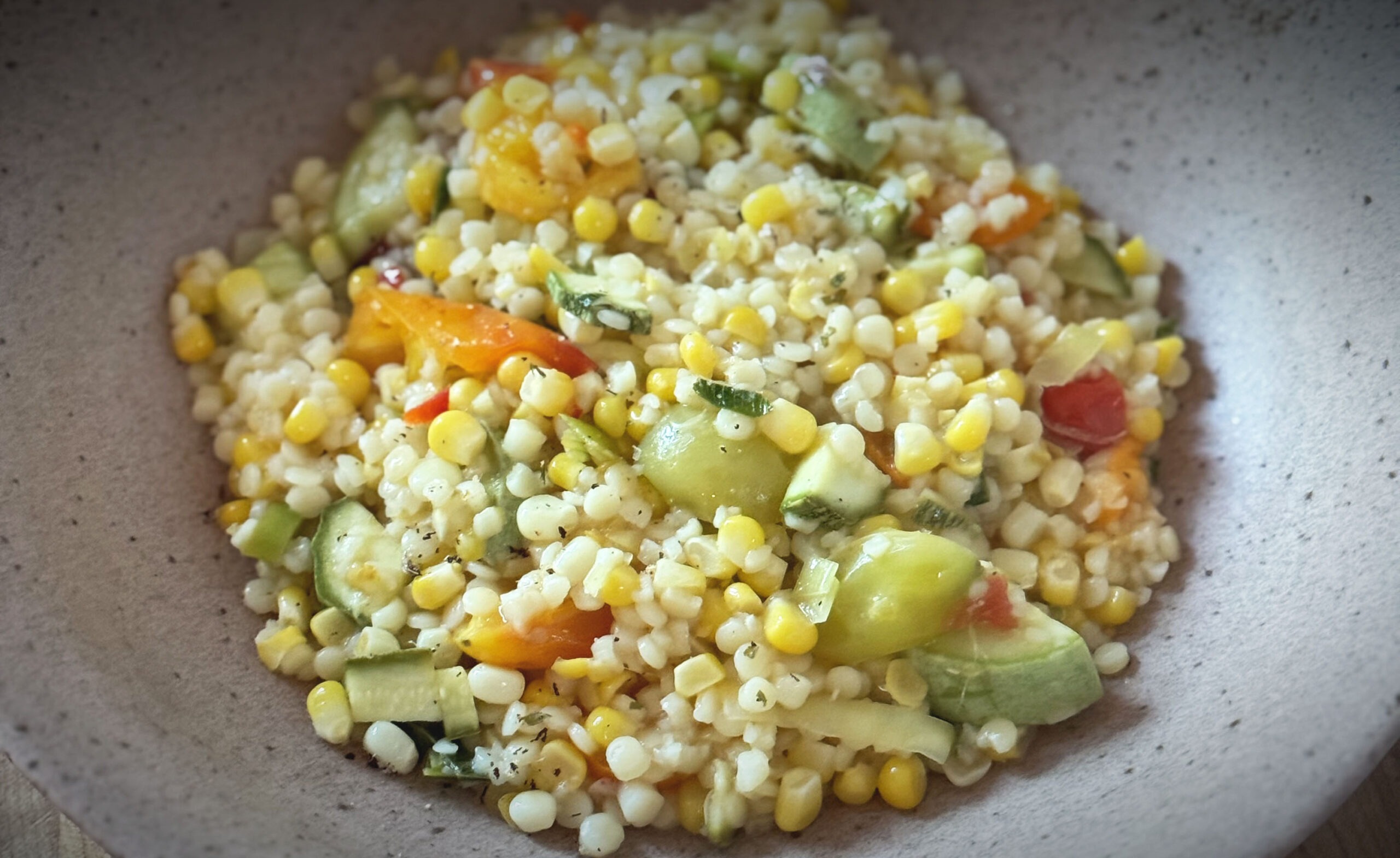
Millet, Sweet Corn & Basil Salad
I’ve been seriously into millet lately, partly as a challenge to incorporate more healthy grains into my diet. I’d been cooking for a picky eater, and once that was over, I felt like I needed to push myself more when it came to grains — which I genuinely adore, especially the weird ones: amaranth, millet, sorghum, and more.
This recipe is one of the simplest things I’ve been making recently, and I even love it cold the next day. Millet, I’ve discovered, is amazing with corn. This salad is really just me tweaking a couscous recipe I created — the big pearl kind of couscous — but truth be told, I love it with millet even more. Its nutty, earthy vibe pairs beautifully with late-summer sweet corn, which seems to take on a deeper, more vegetal tone in that summer-to-fall in-between. Fresh basil leaves and those end-of-summer cherry tomatoes, practically dried on the vine, complete this — like he completes me.
Serves 4
Ingredients
1 cup millet
2 cups water
pinch of salt, plus 1 teaspoon
1 tablespoon extra-virgin olive oil
1 tablespoon butter, unsalted
1 teaspoon lemon zest
1–2 green onions, sliced thin
2–3 ears of corn, kernels removed
1 cup cherry tomatoes, halved
juice of 1 lemon
3 cups cooked millet
handful of roughly torn basil leaves
Directions
Rinse the millet and then add 2 cups water and a pinch of salt; bring to a boil, cover, reduce heat to low, and simmer until the water is absorbed and the grains are tender, about 15 minutes — this makes about 3 cups cooked millet; let rest covered 5 minutes, then fluff with a fork.
Heat the olive oil and butter in a large skillet over medium heat. Add the green onions, lemon zest, and corn. Sauté until the corn is tender and lightly golden, about 4–5 minutes.
Add the cherry tomatoes and cook for another minute, just until they begin to soften. Stir in the lemon juice.
Add the cooked millet and salt, tossing everything together. Cook on low heat for 1–2 minutes until warmed through. Remove from the heat and toss in the basil leaves just before serving.
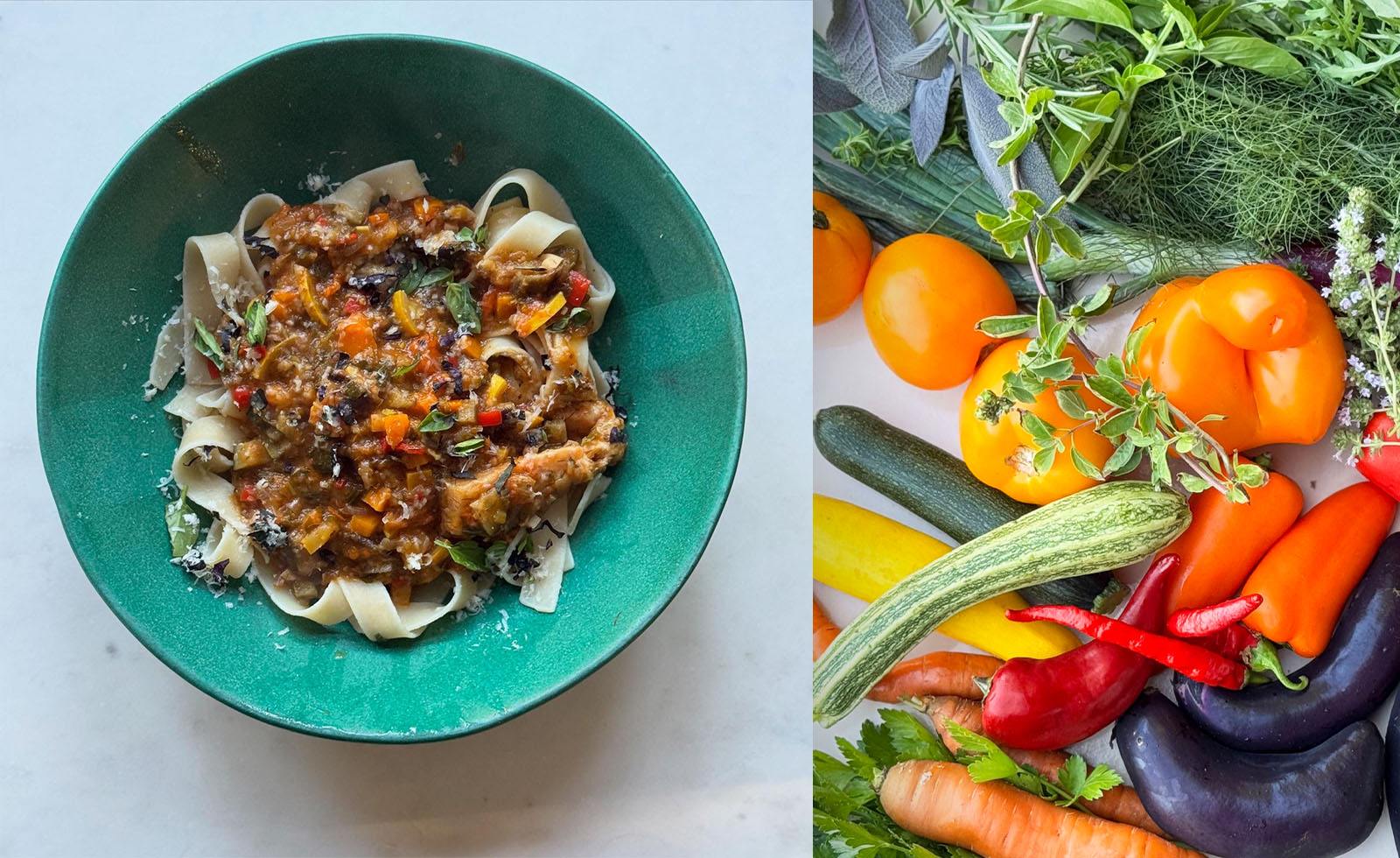
Eggplant & Zucchini Bolognese
This bolognese carries the quiet shift of early fall — when the garden feels messy but alive, and late-season vegetables ask for patience and return give amplified sweetness and depth. It trades summer’s quick, juicy brightness for something slower and more grounded. Eggplant and zucchini are browned first to hold their shape, then coaxed into a silky and sweet sauce of late season heirloom tomatoes that melt into and earthy, comforting, and deeply flavored blanket. A full bevy of late summer, early fall garden herbs are ample — and used generously and at every stage of cooking — layer complexity and depth. It’s the kind of cooking fall invites: slower, intentional, built from what lingers in the garden and rewards you for taking your time both in the journey and the final taste.
Serves 4-6
Ingredients
¼ cup chopped parsley leaves
½ cup chopped basil leaves (ideally purple and green)
2 teaspoons chopped oregano
4–6 medium Japanese or small specialty eggplant, cubed very small
3–4 small yellow and green zucchini, cubed small
2 teaspoons salt
¼ cup extra virgin olive oil, plus a few tablespoons
3–4 cloves garlic, finely chopped
½ teaspoon Calabrian chili flakes
½ cup chopped onion (garden onions with greens ideal)
2 teaspoons chopped rosemary needles
2 teaspoons chopped sage leaves
2 teaspoons chopped summer savory leaves
2 teaspoons chopped marjoram leaves
2 fresh bay leaves
3–4 small carrots, cubed small
3–4 mixed color mini peppers, chopped small
3 cups chopped yellow heirloom tomatoes
1 cup water (as needed)
Directions
Combine the parsley, basil, and oregano and divide in half—you’ll use some at the beginning and the rest at the end. Season the eggplant and zucchini with salt. Heat ¼ cup of the oil in a large, heavy-bottomed pan (like a Le Creuset). Add the eggplant first and cook over medium-low heat, stirring until golden bits appear. Remove and repeat with the zucchini. Set both aside.
Add the remaining olive oil to the pan and keep heat on medium-low. Add garlic, onions, chili flakes, rosemary, sage, marjoram, bay leaves, and savory. Sauté for a few minutes. Add carrots and peppers, and sauté a few more minutes, scraping the pan and stirring constantly. Add half of the parsley-basil-oregano mixture and cook another minute. Deglaze with a bit of water, scraping up all the browned bits, then add the tomatoes. Stir well and let the tomatoes slowly cook down. If they aren’t releasing liquid after 5 minutes, add ½ cup water—more if needed.
Let simmer about 20 minutes, then add the cooked eggplant and zucchini. Simmer another 20 minutes. Stir in the remaining herb mix, turn off the heat, and let sit 10 minutes before serving.
Serve over your choice of pasta, chopped broccoli, or a combo of both. Top each serving with a touch of flake salt, a pinch of freshly grated parmesan, and some fresh basil.

Fresh Fig, Rosemary Butter Cookies
I often flavor sugar by pulverizing it with herbs, spices, zest, or fruit before using it in a recipe — it’s a simple way to carry deeper flavor into whatever I’m baking, cooking, or mixing (I even use this trick for cocktails, like my passion fruit lavender sour for Edible Marin & Wine Country).
This recipe combines that method with two of my favorite things: fresh figs and crisp, buttery cookies. I make them feel deeply fall and warmly aromatic with browned butter and rosemary — one of my all-time favorite herbs in sweets (Lemon-rosemary butter cookies are my winter delight).
These cookies are my fresh, easy answer to fig newtons, one of my favorite cookies and another way to use the abundance of fresh figs I have on the little farm here.
Makes about 20 2-inch cookies
Ingredients
½ cup sugar in the raw
1 teaspoon lemon zest
2 teaspoons finely chopped rosemary leaves, plus 1 teaspoon
3 finely chopped fresh figs, plus 3 more
½ teaspoon salt
2 tablespoons brown sugar
10 tablespoons butter
1 ½ teaspoons vanilla paste
1 cup all-purpose flour
2 tablespoons whole wheat flour
¼ teaspoon baking soda
¼ teaspoon baking powder
½ teaspoon Maldon flake salt
Directions
Using your fingertips, pulverize the rosemary into the ½ cup sugar, rubbing and pressing until the sugar, rosemary, and lemon zest become one fragrant, flavored sugar. Add the chopped figs and, using the back of a spoon, smash them into the sugar mixture until fully combined, forming a cohesive, fragrant, slightly pasty figgy sugar paste. Set aside.
Melt the butter over medium heat, stirring constantly, until it turns deep golden brown, about 8 minutes. Immediately pour into a large bowl and let cool to room temperature, about 8 minutes. Stir in the vanilla.
Add the cooled butter-vanilla mixture to the fig-sugar paste and mix well (use a hand mixer or a wooden spoon).
In a separate bowl, combine the flours, baking soda, and baking powder. Slowly incorporate this dry mix into the butter-fig mixture until a dough forms.
Coarsely chop the remaining 3 figs and gently fold them into the dough. Shape into a cylinder, wrap, and chill until firm.
Preheat the oven to 350°F. Slice the chilled dough into 3/8-inch rounds and place on parchment-lined baking sheets. Bake until light brown and firm, 12-15 minutes. Let cool completely on the sheets set over wire racks.
Mix the remaining teaspoon of finely chopped rosemary with the Maldon salt. While the cookies are still warm, sprinkle a scant pinch of this rosemary salt on top of each.




